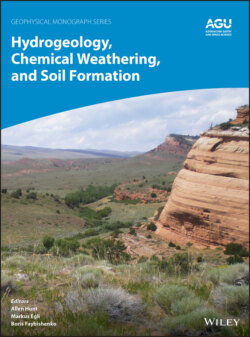Читать книгу Hydrogeology, Chemical Weathering, and Soil Formation - Allen Hunt - Страница 21
1.3.1. Jenny’s Soil System
ОглавлениеTo characterize a soil system, Jenny used the symbols s1, s2, s3, and so forth to stand for soil properties (nitrogen content, acidity, clay content, or whatever). In modern parlance, these properties are state variables, a term adopted by Jenny in his 1980 book. The soil properties are interrelated, such that if one changes the others may also change:
In Jenny’s original discussion of the soil as a system, he distinguished soil formers or soil‐forming factors (climate, relief, parent material, organisms, and time) and explored their relationships to the soil system itself. He later styled them state factors and stressed that they are “independent” variables that condition the state of the soil system (e.g. Jenny, 1980, 10). In Figure 1.1, these variables are shown as atmosphere and hydrosphere (climate), biosphere (organisms), toposphere (relief), and lithosphere (parent material); the entire system changes through time. Jonathan D. Phillips (1989) argued that the purpose and scope of Jenny’s state factors is sometimes misunderstood: they are not intended to describe pedogenetic processes or components of the soil itself; rather, they provide the context and the boundary conditions within which soil formation and development occurs. As Jenny (1961a, 385) put it, “The factors are not formers, or creators, or forces: they are the variables (state factors) that define the state of the soil system.” Jenny made it clear that his factorial approach is very much an ecological approach in which the soil component cannot be considered in isolation from its physical and biotic environment (Jenny, 1961a, 1980). However, it is true to say that Jenny’s work tended to consider the effect of one state factor on a single soil property, all other factors being held constant, and then expressing the relationship as a mathematical function of some kind, usually a linear or curvilinear regression equation. In Figure 1.1, this means that the arrows from the external or driving variables to the soil system are investigated one at a time, and that no interaction between the driving variables or feedback from the soil state variables to the driving variables is considered. Given five state factors, Jenny proposed five broad groups of functions or sequences: climofunctions or climosequences, biofunctions or biosequences, topofunctions or toposequences, lithofunctions or lithosequences, and chronofunctions or chronosequences. He also included dotfunctions and dotsequences to allow for the effects of other factors such as fire. Subsequent work has established a host of such functions and sequences (see Yaalon, 1975; Huggett, 1998; Birkeland, 1999).
Figure 1.1 The soil system.
